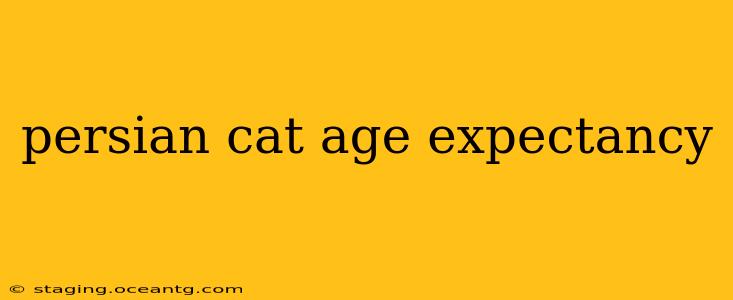Persian cats, with their luxurious coats and sweet dispositions, are beloved companions worldwide. Understanding their lifespan and the factors that influence it is crucial for responsible ownership. This guide delves into the average lifespan of a Persian cat, common health concerns that can affect their longevity, and steps you can take to ensure your feline friend enjoys a long and healthy life.
What is the Average Lifespan of a Persian Cat?
The average lifespan of a Persian cat is 10 to 17 years, although some may live even longer. Several factors contribute to this range, including genetics, diet, healthcare, and overall environment. While a longer lifespan is certainly achievable, responsible ownership plays a pivotal role in achieving it.
What Factors Affect a Persian Cat's Lifespan?
Several key factors can influence how long your Persian cat lives:
Genetics:
Breed predispositions play a significant role. Certain genetic conditions are more prevalent in Persians than in other breeds. Understanding your cat's lineage and potential hereditary risks is crucial.
Diet and Nutrition:
A balanced, high-quality diet is paramount. Feeding your Persian cat a diet specifically formulated for their age and health needs ensures they receive the necessary nutrients for optimal health and longevity. Avoid feeding table scraps, as these can upset their digestive system and contribute to health issues.
Healthcare and Preventative Care:
Regular veterinary checkups are essential. Early detection and treatment of health problems significantly increase the chances of a longer, healthier life. Vaccinations, parasite prevention, and dental care are crucial preventative measures.
Environmental Factors:
A safe and enriching environment contributes significantly to a cat's well-being. This includes minimizing stress, providing ample opportunities for play and exploration, and ensuring a clean and comfortable living space.
Lifestyle:
An active and engaged lifestyle helps to prevent obesity and encourages overall well-being. Interactive play sessions, climbing structures, and puzzle feeders can help keep your Persian cat mentally and physically stimulated.
Common Health Issues in Persian Cats Affecting Lifespan:
Persian cats are prone to certain health issues that can shorten their lifespan if left untreated. These include:
- Polycystic Kidney Disease (PKD): A genetic disorder affecting the kidneys.
- Progressive Retinal Atrophy (PRA): A degenerative eye disease leading to blindness.
- Hypertrophic Cardiomyopathy (HCM): A thickening of the heart muscle.
- Dental Problems: Their flat faces can lead to dental crowding and subsequent issues.
- Respiratory Issues: Brachycephalic (short-nosed) breeds are susceptible to breathing problems.
How Can I Help My Persian Cat Live a Longer Life?
Providing your Persian cat with the best possible care increases their chances of living a long and healthy life. This includes:
- Regular Veterinary Checkups: Schedule annual wellness examinations and address any health concerns promptly.
- High-Quality Diet: Choose a premium cat food formulated for the breed and age.
- Dental Hygiene: Brush your cat's teeth regularly to prevent dental disease.
- Safe and Stimulating Environment: Provide a comfortable, clean, and enriched environment.
- Preventative Healthcare: Administer vaccinations and parasite preventatives as recommended by your veterinarian.
What are some signs of aging in Persian cats?
As Persian cats age, they may exhibit several signs of senescence, including decreased activity levels, changes in appetite, weight loss or gain, cognitive decline (similar to dementia in humans), and changes in coat condition. Regular veterinary checkups are vital in monitoring these changes and addressing any potential health issues.
How long do indoor Persian cats live compared to outdoor cats?
Indoor Persian cats generally live longer than outdoor cats. Indoor cats are protected from accidents, fights, diseases, and parasites common in outdoor environments. A controlled environment contributes significantly to increased lifespan.
What are the signs of a healthy Persian cat?
A healthy Persian cat typically displays a shiny coat, bright eyes, alert demeanor, normal appetite and bowel movements, and playful behavior. Any deviations from this should prompt a veterinary consultation.
By proactively addressing these aspects of your Persian cat's care, you can significantly improve their chances of enjoying a long, happy, and fulfilling life by your side. Remember, responsible ownership is the key to maximizing your beloved Persian's lifespan.
